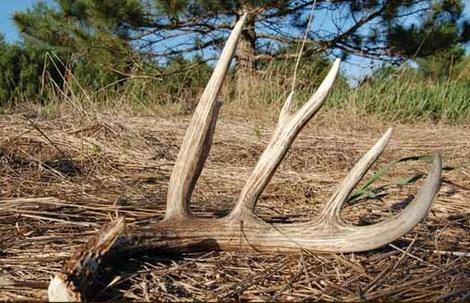Deer Antler Sheds

Here are some interesting shed facts, along with tips to help you find more antlers.
—After the rut, decreasing testosterone levels cause an “abscission layer” to form between the antlers and their pedicels. As the connective tissue dissolves, the bucks’ antlers become loose and fall off.
—Bucks drop their racks from late December in the North through March and April in the South.
—Weather, snow depth, altitude and particularly food availability and nutritional value can influence when antler loss takes place.
—If your area has an early rut, bucks’ testosterone levels will decrease earlier and, as a result, some deer will cast their racks two to four weeks earlier than usual. A severe winter with a lot of snow can also cause stressed deer to shed earlier.
—It was once believed that bucks withdrew to a secluded place to shed their antlers—away from does and rival bucks—thus avoiding a public loss of virility. Today’s top biologists nix that idea, saying deer are probably unaware of when and where they’ll lose their headgear.
—Most older bucks shed antlers earlier than younger bucks do.
—According to Hellickson, the specific time a buck will shed his antlers might be determined heavily by his individual antler cycle. This is independent of other bucks’ cycles and is probably centered on birth date.
—A study in Mississippi found that individual penned bucks usually shed their antlers during the same week each year. Other studies of captive deer show that bucks usually shed both antlers within three days of each other.
HOW TO FIND MORE SHEDS
—Don’t hunt too early. If you bump a one-antlered monster, it’s not likely you’ll find both sheds in that area.
—Glass winter-feeding areas where deer congregate (e.g., corn, soybean and hay lots) every few days until you see few, if any, bucks with antlers. Then start looking.
—Another option is to hang digital trail cameras around feeding areas, or even near bait piles, if they are legal in your area. Once the bucks in your images go antlerless, start hunting hard.
—Check trails that enter and exit a feed field. Bucks often walk only 100 to 300 yards and then lie down out of the wind on the first east- or south-facing hillside. You might find sheds on or just off a trail or along the bedding slope
Another interesting post from 2017 about sheds– WE SHOULD EXPECT A STATEMENT ALLOWING FOR SHED COLLECTING


Hows your shed hunting going Show your sheds off
https://nockedup.net/nockedup/share-your-outdoor-adventures-with-us/